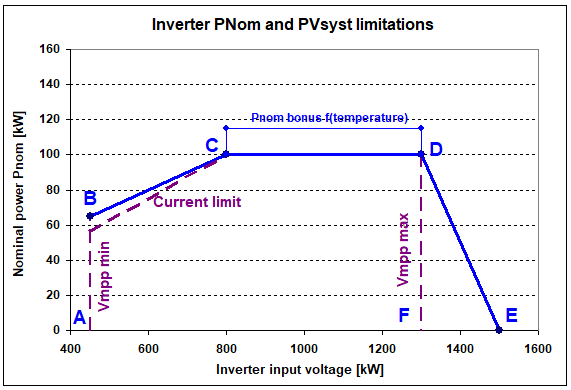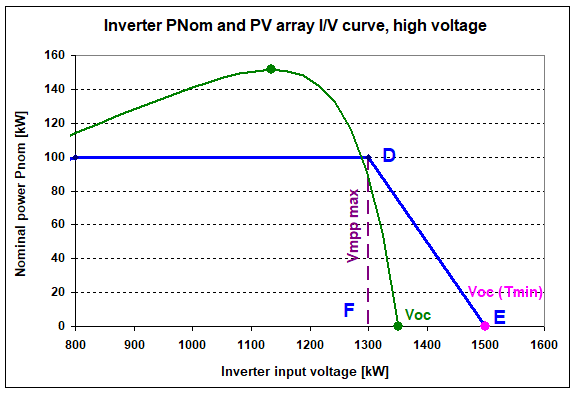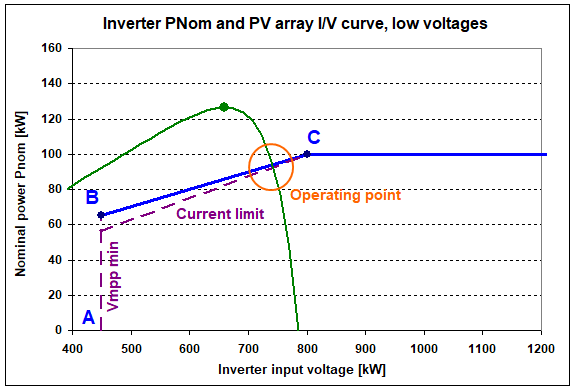|
<< Click to Display Table of Contents >> Inverter Pnom as f (voltage) |
  
|
|
<< Click to Display Table of Contents >> Inverter Pnom as f (voltage) |
  
|
Some (few) inverter manufacturers now specify a nominal power curve (Pnom), as function of the input voltage.
These curves look like the following blue curve:

The plateau C - D is the nominal power PNom. Here we have chosen 100 kW, so that you can interprete the Y-axis either as Powers, or as a percentages of P / Pnom (100%).
The additional value between C and D corresponds to the possible bonus when the inverter temperature is not too high (up to PMax in PVsyst).
The voltage at the point D corresponds to the Maximum Operating Voltage, named VmppMax in PVsyst.
There is a linear decrease from the point D to E, where E is usually the Maximum allowed input voltage (VAbsMax in PVsyst).
We observed on most real specifications that the ratio VmppMax / VAbsMax is of the order of 85%.
At low voltages, the segment B-C corresponds indeed to an input current limitation. We can check this on the specified values: the current at point C ( I (C) = PNom(C) / V (C) ) is equal (or close) to the current at point B ( I (B) = PNom(B) / V (B) ),
In fact, the voltage at point B is the Minimum voltage VmppMin of PVsyst, And C corresponds to the "Minimum Voltage for PNom" specified in PVsyst,
In the "real" inverter, when we apply an I/V curve on this graph: if the Pmpp is higher than the PNom curve, the inverter will move the operating point on the I/V curve towards higher voltages, until reaching the authorized power, i.e. the intersection of the I/V curve with the blue curve. .
In the PVsyst simulation, the behaviour is the same, except that the limiting values will be the violet dotted curves.
During the simulation, the Overload loss will be the difference between the Pmpp and the power of this intesection point.
All I/V curves with a Pmpp within these limits will not lead to any overload losses.
Let us study the effect of the I/V curve of the PV array.
The diagram shows an I/V curve with power overload, for the higher possible (reasonable) voltage of the PV array within your system. This voltage is limited by the Voc value at the operating array temperature.
There are two contributions for the evaluation of the temperature in high power operating conditions:
▪First, remember that we have defined a reference low temperature (the lower ambient temperatures of this site) for the evaluation of the highest possible Voc, In this example, we have supposed an operating temperature at least 10 °C above this minimum, which seems reasonable for a high power operating condition.
▪When running at sun, the PV array will obviously heat up. The temperature increase under 1000 W/m2 is about 25°C when we define a Heat loss factor Uc = 29 W/m2.
Therefore we have a temperature difference of at least 35 °C between the lower reference temperature - at which Voc <= VAbsMax - and the operating condition. If we suppose a usual muVco coefficient = -0.3 %/°C, this means that the minimum voltage drop on Voc is equal to Voc(TMin) * muVoc * (Toper - Tmin) = 158 V.

The operating point is the intersection of the falling edge of I/V curve and the PNom limit.
If this is below thepoint D, no problem, the overload is calculated correctly as the difference between Pmpp and PNom.
If the I/V curve passes on the right of the point D:
▪In PVsyst, there is no possible operating point, the inverter has to stop (the output will be null).
▪In the situation of inverter's specification, the operating point would be the intersection of the I/V curve and the segment D-E. We could recover a part of the power.
This situation is identified in PVsyst, by a warning message for each hour when this arises. In the great majority of well-sized systems, this never arises, so that this D-E specification has no effect.
When the overload arises at lower voltages than the operating point (intersection) may be
▪either on the Pnom horizontal line, this case is correctly treated in PVsyst, and leads to a usual Power overload loss
▪or on the B-C segment.In this case PVsyst treats the power loss (difference between Pmpp and operating point) as a "maximum current loss". We can see that the difference between the PVsyst normal behaviour and the specification is insignificant close to the point B, and may increases when the voltage diminishes and the specification is not representative of a constant current limit.

We will adapt the PVsyst simulation behaviour in the future. But this is not in our priorities as the effect on most simulations is marginal.